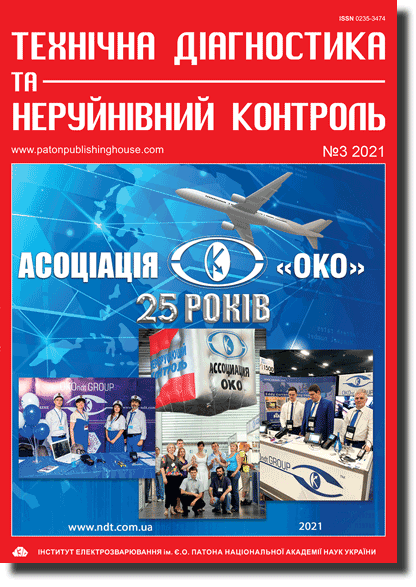| 2021 №03 (01) |
DOI of Article 10.37434/tdnk2021.03.02 |
2021 №03 (03) |

"Tekhnichna Diahnostyka ta Neruinivnyi Kontrol" (Technical Diagnostics and Non-Destructive Testing) #3, 2021, pp. 14-18
Multiscale procedure of numerical assessment of damage rate and technical state of structures from fibrous materials
O.S. Milenin, O.A. Velikoivanenko, G.P. Rozynka, N.I. Pivtorak
E.O. Paton Electric Welding Institute of the NAS of Ukraine 11 Kazymyr Malevych Str., 03150, Kyiv, Ukraine. E-mail: office@paton.kiev.ua
РA multiscale procedure was developed for prediction of stress-strain, damaged and boundary states of structures from typical fibrous composite materials. The methodology is based on a combination of macroscale models for describing the state of structurally inhomogeneous brittle materials and mesoscale approaches of continuous modeling of damage development under the impact of external loading. The features of the impact of external loading on material damage level and boundary state of structures were studied in the case of large-sized cylindrical pressure vessels from glass and carbon fibre-reinforced composites. Ref. 11, Fig. 5.
Keywords: composite materials, damage rate, boundary state, mathematical modeling, multiscale procedure
Received: 13.09.2021
References
1. Kiruthika, A.V. (2017) A review on physico-mechanical properties of bast fibre reinforced polymer composites. Journal of Building Engineering, 9, 91-99. https://doi.org/10.1016/j.jobe.2016.12.0032. Yao, S.-S., Jin, F.-L., Rhee, K.Y. et al. (2018) Recent advances in carbon-fiber-reinforced thermoplastic composites: A review. Composites Part B: Engineering, 142, 241-250. https://doi.org/10.1016/j.compositesb.2017.12.007
3. Böer, P., Holliday, L., Kang, T.H.-K. (2013) Independent envirometal effects on durability of fibe-reinforces polymer wraps in civil applications: A riview. Construction and Building Materials, 48, 360-370. https://doi.org/10.1016/j.conbuildmat.2013.06.077
4. Kortschot, M.T., Beaumont, P.W.R. (1990) Damage mechanics of composite materials: I - Measurements of damage and strength. Composites Science and Technology, 39, 4, 289-301. https://doi.org/10.1016/0266-3538(90)90077-I
5. Milenin, O.S., Velikoivanenko, O.A., Rozynka, G.P., Pivtorak, N.I. (2021) Finite elements methods for assessment of the technical condition of large-sized structures from structurally heterogeneous materials (Review). Tekh. Diahnost. ta Neruiniv. Kontrol, 2, 14-19 [in Russian] https://doi.org/10.37434/tdnk2021.02.02
6. Bargmann, S., Klusemann, B., Markmann, J. et al. (2018) Generation of 3D representative volume elements for heterogeneous materials: A review. Progress in Materials Science, 96, 322-384. https://doi.org/10.1016/j.pmatsci.2018.02.003
7. Velikoivanenko, Е.A., Milenin, A.S., Popov, A.V. et al. (2019) Methods of numerical forecasting of the working performance of welded structures on computers of hybrid architecture. Cybernetics and Systems Analysis, 55, 1, 117- 127. https://doi.org/10.1007/s10559-019-00117-8
8. Abdel Ghafaar, M., Mazen, A.A. (2006) Application of the rule of mixtures and Halpin-Tsai equations to woven fabric reinforced epoxy composites. Journal of Engineering Sciences, 34, 1, 227-236. https://doi.org/10.21608/jesaun.2006.110251
9. Buragohain, M.K. (2017) Micromechanics of a Lamina. Composite Structures. Design, Mechanics, Analysis, Manufacturing, and Testing. USA CRC Press. https://doi.org/10.1201/9781315268057
10. Nyambeni, N., Mabuza, B.R. (2018) Considerations of Failure Analysis in a Multi-Layered Composite Structure under Thermomechanical Loading. Proceedings, 2, 8, 447. https://doi.org/10.3390/ICEM18-05329
11. Naresh, K., Shankar, K., Velmurugan, R. (2018) Reliability analysis of tensile strengths using Weibull distribution in glass/epoxy and carbon/epoxy composites. Composites Part B: Engineering, 133, 129-144. https://doi.org/10.1016/j.compositesb.2017.09.002
Advertising in this issue:
The cost of subscription/purchase order journals or individual articles
| Journal/Currency | Annual Set | 1 issue printed |
1 issue |
one article |
| TPWJ/USD | 384 $ | 32 $ | 26 $ | 13 $ |
| TPWJ/EUR | 348 € | 29 € | 24 € | 12 € |
| TPWJ/UAH | 7200 UAH | 600 UAH | 600 UAH | 280 UAH |
| AS/UAH | 1800 UAH | 300 UAH | 300 UAH | 150 UAH |
| AS/USD | 192 $ | 32 $ | 26 $ | 13 $ |
| AS/EUR | 180 € | 30 € | 25 € | 12 € |
| SEM/UAH | 1200 UAH | 300 UAH | 300 UAH | 150 UAH |
| SEM/USD | 128 $ | 32 $ | 26 $ | 13 $ |
| SEM/EUR | 120 € | 30 € | 25 € | 12 € |
| TDNK/UAH | 1200 UAH | 300 UAH | 300 UAH | 150 UAH |
| TDNK/USD | 128 $ | 32 $ | 26 $ | 13 $ |
| TDNK/EUR | 120 € | 30 € | 25 € | 15 € |
AS = «Automatic Welding» - 6 issues per year;
TPWJ = «PATON WELDING JOURNAL» - 12 issues per year;
SEM = «Electrometallurgy Today» - 4 issues per year;
TDNK = «Technical Diagnostics and Non-Destructive Testing» - 4 issues per year.









